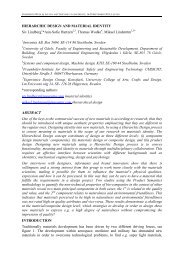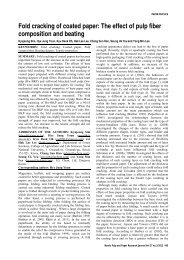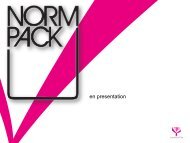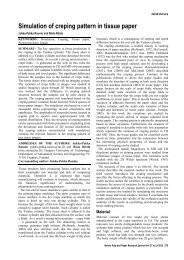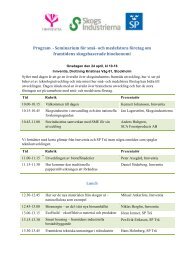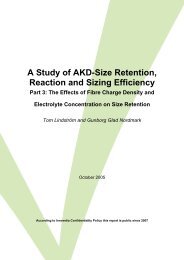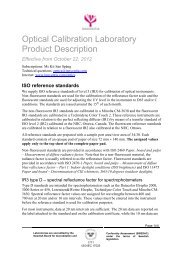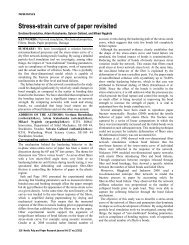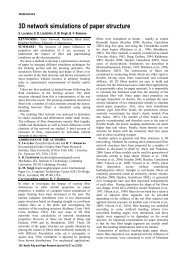Engineering fracture mechanics analysis of paper ... - Innventia.com
Engineering fracture mechanics analysis of paper ... - Innventia.com
Engineering fracture mechanics analysis of paper ... - Innventia.com
You also want an ePaper? Increase the reach of your titles
YUMPU automatically turns print PDFs into web optimized ePapers that Google loves.
PAPER PHYSICS<br />
<strong>Engineering</strong> <strong>fracture</strong> <strong>mechanics</strong> <strong>analysis</strong> <strong>of</strong> <strong>paper</strong> materials<br />
Petri Mäkelä<br />
KEYWORDS: Fracture, Failure, Notch, Crack,<br />
Strength, Web break, Tensile stiffness, Plasticity<br />
SUMMARY: The aim <strong>of</strong> the present work was to<br />
develop an analytic <strong>fracture</strong> <strong>mechanics</strong> procedure that<br />
enables accurate predictions <strong>of</strong> failure <strong>of</strong> <strong>paper</strong> materials.<br />
Analytic expressions for prediction <strong>of</strong> the critical force<br />
and critical elongation <strong>of</strong> edge-notched <strong>paper</strong> webs were<br />
developed based on isotropic deformation theory <strong>of</strong><br />
plasticity and -integral theory. The analytic expressions<br />
were applied to predict the critical force and elongation <strong>of</strong><br />
<strong>paper</strong> webs with different edge-notch sizes for six<br />
different <strong>paper</strong> materials. The accuracy <strong>of</strong> the analytic<br />
failure predictions was verified by numerical predictions<br />
and experiments on edge-notched <strong>paper</strong> webs, showing<br />
that the developed engineering <strong>fracture</strong> <strong>mechanics</strong><br />
<strong>analysis</strong> procedure predicted failure accurately.<br />
ADDRESSES OF THE AUTHORS: Petri Mäkelä<br />
(petri.makela@tetrapak.<strong>com</strong>), Tetra Pak Packaging<br />
Solutions AB, Ruben Rausings gata, SE-221 86 Lund,<br />
Sweden.<br />
Corresponding author: Petri Mäkelä<br />
Paper materials <strong>com</strong>monly exhibit undesired <strong>fracture</strong>s in<br />
manufacture, converting and end-use, but there is still no<br />
generally accepted <strong>fracture</strong> <strong>mechanics</strong> model available<br />
for predicting failures <strong>of</strong> notched <strong>paper</strong> structures.<br />
Previous work have shown that linear elastic <strong>fracture</strong><br />
<strong>mechanics</strong> has limited applicability to <strong>paper</strong> materials<br />
(Seth and Page 1974; Uesaka et al. 1979, Mäkelä and<br />
Östlund 1999, Mäkelä 2002), while non-linear <strong>fracture</strong><br />
<strong>mechanics</strong> <strong>of</strong>fers quantitative predictions <strong>of</strong> failure even<br />
when analysing small-sized defects in <strong>paper</strong> materials<br />
that exhibit pronounced non-linear material behaviour<br />
(Mäkelä and Östlund 1999; Wellmar et al. 2000, Mäkelä<br />
et al. 2009).<br />
In a previous study (Mäkelä et al. 2009), a non-linear<br />
<strong>fracture</strong> <strong>mechanics</strong> model based on isotropic deformation<br />
theory <strong>of</strong> plasticity and -integral theory is applied for<br />
predicting failure <strong>of</strong> <strong>paper</strong> materials. The <strong>fracture</strong><br />
<strong>mechanics</strong> model is calibrated for six different <strong>paper</strong><br />
materials based on laboratory material testing, involving<br />
determination <strong>of</strong> the <strong>fracture</strong> toughness by finite element<br />
<strong>analysis</strong> <strong>of</strong> laboratory <strong>fracture</strong> toughness tests. The<br />
calibrated <strong>fracture</strong> <strong>mechanics</strong> models are used to<br />
numerically predict failure <strong>of</strong> large edge-notched <strong>paper</strong><br />
webs for each <strong>of</strong> the investigated <strong>paper</strong> materials. The<br />
accuracy <strong>of</strong> the failure predictions are verified by tensile<br />
testing <strong>of</strong> edge-notched <strong>paper</strong> webs for the different<br />
investigated <strong>paper</strong> materials and several different notch<br />
sizes. The verification study shows that the numerical<br />
predictions <strong>of</strong> failure are in excellent agreement with the<br />
experiments. Consequently, the work by Mäkelä et al.<br />
(2009) shows that isotropic deformation theory <strong>of</strong><br />
plasticity and -integral theory constitute an accurate<br />
<strong>fracture</strong> <strong>mechanics</strong> modelling level for <strong>paper</strong> materials.<br />
In a recent work (Mäkelä, Fellers 2012), a neat analytic<br />
procedure for calibrating the isotropic deformation theory<br />
<strong>of</strong> plasticity model based on laboratory tensile test data is<br />
developed. The analytic procedure is used to calibrate the<br />
isotropic theory <strong>of</strong> plasticity model for six different <strong>paper</strong><br />
materials. The calibrated models are experimentally<br />
verified to accurately model the tensile behaviour <strong>of</strong> the<br />
investigated <strong>paper</strong> materials. In the same work, a closedform<br />
analytic expression for determination <strong>of</strong> the <strong>fracture</strong><br />
toughness <strong>of</strong> <strong>paper</strong> materials based on laboratory <strong>fracture</strong><br />
toughness test data is developed. The analytic expression<br />
is used to determine the <strong>fracture</strong> toughness <strong>of</strong> the six<br />
investigated <strong>paper</strong> materials and is shown to determine<br />
the <strong>fracture</strong> toughness in excellent agreement with finite<br />
element <strong>analysis</strong> <strong>of</strong> laboratory <strong>fracture</strong> toughness tests.<br />
The work by Mäkelä and Fellers (2012) therefore shows<br />
that a non-linear <strong>fracture</strong> <strong>mechanics</strong> model can be<br />
calibrated without encountering numerical <strong>com</strong>plexities.<br />
The aim <strong>of</strong> the present work was to develop an analytic<br />
procedure for predicting failure <strong>of</strong> notched <strong>paper</strong> webs<br />
based on a calibrated non-linear <strong>fracture</strong> <strong>mechanics</strong><br />
model. Such analytic procedure would enable<br />
engineering <strong>fracture</strong> <strong>mechanics</strong> <strong>analysis</strong> <strong>of</strong> <strong>paper</strong><br />
materials, making it possible to predict failure <strong>of</strong> notched<br />
<strong>paper</strong> webs based on laboratory test data, without<br />
encountering numerical <strong>com</strong>plexities.<br />
Nomenclature<br />
All equations in this work treat the in-plane mechanical<br />
behaviour <strong>of</strong> <strong>paper</strong> materials, assuming small<br />
deformation theory and plane stress conditions. All<br />
presented equations are based on the engineering stress<br />
format (force per unit width per unit thickness). The<br />
equations also apply to other stress formats, such as the<br />
line load format (force per unit width) or the specific<br />
stress format (force per unit width per unit grammage),<br />
provided that all used material parameters adhere to the<br />
same stress format convention. However, the equations<br />
involving the thickness (Eqs 5, 9 and 12), have to be<br />
slightly modified when altering the stress format. The<br />
thickness, denoted by , in these equations should be set<br />
to unity when applying the line load format, while it<br />
should be substituted by the grammage, denoted by ,<br />
when applying the specific stress format.<br />
Materials and Methods<br />
Materials<br />
Six <strong>com</strong>mercial grades <strong>of</strong> <strong>paper</strong> and board were<br />
investigated, viz. Fluting <strong>paper</strong> (Fluting), Sack <strong>paper</strong><br />
(Sack), Newsprint (News), Testliner (Liner), Mediumweight<br />
coated <strong>paper</strong> (MWC), and Supercalendered <strong>paper</strong><br />
(SC). The selected <strong>paper</strong> materials <strong>com</strong>prised widely<br />
different pulping conditions, <strong>paper</strong>making strategies, and<br />
end-use requirements.<br />
Nordic Pulp and Paper Research Journal Vol 27 no.2/2012 361
PAPER PHYSICS<br />
Table 1. Summary <strong>of</strong> the structural properties <strong>of</strong> the investigated <strong>paper</strong> materials.<br />
Property Fluting Sack News Liner MWC SC<br />
Grammage, / g/m 2 111 79 45 100 90 51<br />
Structural thickness, / μm 145 104 60.9 150 75.4 41.7<br />
Structural density, / kg/m 3 766 762 739 668 1194 1223<br />
Table 2. Summary <strong>of</strong> the tensile material parameters and <strong>fracture</strong> toughness in MD <strong>of</strong> the investigated <strong>paper</strong> materials.<br />
Property Fluting Sack News Liner MWC SC<br />
Tensile stiffness index, / MNm/kg 12.0 10.4 9.78 7.61 7.52 7.27<br />
Strain-hardening modulus index, / kNm/kg 518 376 217 181 216 176<br />
Strain-hardening exponent, 3.29 3.43 4.65 4.35 3.69 4.18<br />
Fracture toughness index, / Jm/kg 6.10 13.4 3.43 5.30 3.98 2.43<br />
Table 3. Summary <strong>of</strong> the tensile material parameters and <strong>fracture</strong> toughness in CD <strong>of</strong> the investigated <strong>paper</strong> materials.<br />
Property Fluting Sack News Liner MWC SC<br />
Tensile stiffness index, / MNm/kg 3.79 4.58 2.47 2.82 3.18 2.35<br />
Strain-hardening modulus index, / kNm/kg 59.7 194 34.8 53.5 45.3 30.0<br />
Strain-hardening exponent, 7.06 2.58 7.60 4.99 5.40 6.32<br />
Fracture toughness index, / Jm/kg 8.15 28.6 4.69 10.7 5.84 3.34<br />
The <strong>paper</strong> materials were supplied as wrapped wound<br />
rolls from different European mills. The web width <strong>of</strong> the<br />
supplied rolls ranged between 0.95 m and 1.8 m. The<br />
rolls were unwrapped and the outermost <strong>paper</strong> layers<br />
were discarded. The unwrapped rolls were acclimatized<br />
two weeks in a controlled climate <strong>of</strong> 23°C and 50% RH<br />
before further actions were taken.<br />
Laboratory experiments<br />
Paper samples for laboratory experiments were collected<br />
from the supplied <strong>paper</strong> rolls. All <strong>paper</strong> samples were<br />
conditioned (ISO 187) before laboratory testing. The<br />
grammage (ISO 536) and the structural thickness and<br />
density (SCAN-P88:01) were determined. The structural<br />
properties <strong>of</strong> the investigated <strong>paper</strong> materials are<br />
summarised in Table 1.<br />
Tensile testing and <strong>fracture</strong> toughness testing were<br />
performed in MD and CD for all investigated <strong>paper</strong><br />
materials. The testing was performed following ISO<br />
1924-3, with the exception that the <strong>fracture</strong> toughness<br />
testing was performed on centre-notched test pieces using<br />
an anti-buckling device. More detailed descriptions <strong>of</strong> the<br />
laboratory material testing are given in previous work<br />
(Mäkelä and Fellers 2012; Mäkelä et al. 2009).<br />
Material modelling<br />
The uniaxial tensile material behaviour <strong>of</strong> the<br />
investigated <strong>paper</strong> materials was modelled using an<br />
isotropic deformation theory <strong>of</strong> plasticity model that<br />
relates strain, , to stress, , as given by,<br />
where denotes the tensile stiffness, is the strainhardening<br />
modulus, and denotes the strain-hardening<br />
exponent.<br />
[1]<br />
Calibration <strong>of</strong> material model<br />
The material model in Eq 1 was calibrated based on the<br />
laboratory tensile test data. The tensile stiffness, ,<br />
tensile strength, , strain at break, , and tensile energy<br />
absorption, , were determined following a procedure<br />
suggested by Mäkelä and Fellers (2012), which closely<br />
resembles ISO 1924-3. The strain-hardening exponent, ,<br />
and the strain-hardening modulus, , were determined<br />
using the following two analytic expressions, which were<br />
suggested by Mäkelä and Fellers (2012):<br />
The determined tensile stiffness, strain-hardening<br />
exponent, and strain-hardening modulus in MD and CD<br />
are summarised in Tables 2-3 for the investigated <strong>paper</strong><br />
materials.<br />
Determination <strong>of</strong> <strong>fracture</strong> toughness<br />
The <strong>fracture</strong> toughness, , was determined based on the<br />
<strong>fracture</strong> toughness test data, using the following analytic<br />
expression that was suggested by Mäkelä and Fellers<br />
(2012),<br />
where denotes the size <strong>of</strong> the notch in the <strong>fracture</strong><br />
toughness test pieces after symmetry considerations<br />
( =10 mm). The critical net-section stress, , in Eq. 4<br />
was evaluated from the <strong>fracture</strong> toughness test data using,<br />
[2]<br />
[3]<br />
[4]<br />
[5]<br />
362 Nordic Pulp and Paper Research Journal Vol 27 no.2/2012
PAPER PHYSICS<br />
where denotes the critical force, i.e. the force at break<br />
in the <strong>fracture</strong> toughness test, is the thickness <strong>of</strong> the<br />
<strong>paper</strong> material, and is the width <strong>of</strong> the <strong>fracture</strong><br />
toughness test piece after symmetry considerations<br />
( =25 mm). The determined <strong>fracture</strong> toughness in MD<br />
and CD are summarised in Tables 2-3 for the investigated<br />
<strong>paper</strong> materials.<br />
Tensile testing <strong>of</strong> large edge-notched <strong>paper</strong> webs<br />
The conditioned <strong>paper</strong> rolls were edge-trimmed in order<br />
to obtain a precise web width and to remove possible<br />
edge-damages caused by the previous transport and<br />
handling <strong>of</strong> the rolls. The web width after edge-trimming<br />
was 0.8 m for the fluting <strong>paper</strong> and sack <strong>paper</strong>, 0.95 m<br />
for the Medium-weight coated <strong>paper</strong>, and 1 m for the<br />
three remaining <strong>paper</strong> grades. The edge-trimming as well<br />
as the subsequent testing <strong>of</strong> the <strong>paper</strong> webs were<br />
performed in a controlled climate <strong>of</strong> 23°C and 50% RH.<br />
The tensile testing <strong>of</strong> the large edge-notched <strong>paper</strong> webs<br />
was performed using the Wide Web Tensile Tester, a<br />
custom-built tensile tester developed at PFI in Norway<br />
(see Fig 1). The edge-trimmed <strong>paper</strong> web samples were<br />
mounted in the tensile tester using a clamping length <strong>of</strong><br />
1.88 m.<br />
A sharp razor blade was used to introduce a notch in the<br />
edge <strong>of</strong> the <strong>paper</strong> web before the initiation <strong>of</strong> the test. The<br />
notch was oriented along CD and its location was<br />
alternated between the left and right edge <strong>of</strong> the <strong>paper</strong><br />
web throughout the experimental trials, in order to reduce<br />
possible systematic influence <strong>of</strong> non-uniform material<br />
behaviour or skew loading on the test data. Several<br />
different notch sizes with lengths ranging from 1 mm to<br />
40 mm were studied for each <strong>of</strong> the investigated <strong>paper</strong><br />
materials. An anti-buckling guide, <strong>com</strong>posed <strong>of</strong> two<br />
Plexiglas sheets that were placed on each side <strong>of</strong> the<br />
<strong>paper</strong> web, was used to prevent out-<strong>of</strong>-plane buckling <strong>of</strong><br />
the notched region <strong>of</strong> the <strong>paper</strong> web during the tests.<br />
All tests exhibiting obvious irregularities, such as skew<br />
mounting <strong>of</strong> the web or slippage in the clamping region,<br />
were rejected. Such irregularities, which caused nonuniform<br />
loading <strong>of</strong> the web, were detected by the<br />
formation <strong>of</strong> unsymmetrical web wrinkling patterns. The<br />
tensile testing <strong>of</strong> the notched <strong>paper</strong> webs are described in<br />
more detail in previous work (Mäkelä et al. 2009).<br />
Finite element <strong>analysis</strong><br />
The <strong>com</strong>mercial finite element code ABAQUS/Standard<br />
(ver 6.3) was used to analyse the tensile tests for the large<br />
edge-notched <strong>paper</strong> webs. An isotropic deformation<br />
theory <strong>of</strong> plasticity model, which extends Eq 1 to<br />
multiaxial conditions, was used to model the material<br />
behaviour. The used model establishes a one-to-one<br />
relation between the <strong>com</strong>ponents <strong>of</strong> the strain tensor, ,<br />
and the <strong>com</strong>ponents <strong>of</strong> the stress tensor, , given by,<br />
where denote the <strong>com</strong>ponents <strong>of</strong> the linear elastic<br />
<strong>com</strong>pliance tensor, is the von Mises effective stress,<br />
and denote the <strong>com</strong>ponents <strong>of</strong> the deviatoric stress<br />
tensor. The parameters and denote the strain-<br />
[6]<br />
Fig 1. The Wide Web Tensile Tester (PFI, Norway).<br />
x<br />
y<br />
Crack tip<br />
Symmetry cut<br />
Fig 2. Illustration <strong>of</strong> the used finite element mesh (edge-cracked<br />
rectangular panel with one half <strong>of</strong> the structure modelled after<br />
symmetry considerations).<br />
hardening modulus and strain-hardening exponent,<br />
respectively.<br />
Three linear elastic material parameters, the tensile<br />
stiffness, , the Poisson’s ratio, , and the shear modulus,<br />
, are required to model the multiaxial linear elastic<br />
behaviour <strong>of</strong> isotropic materials. The tensile stiffness was<br />
collected from Tables 2-3, the Poisson’s ratio was<br />
assumed to be 0.293 (Baum et al. 1981), and the shear<br />
modulus is defined by Eq 7. These three material<br />
parameters define the <strong>com</strong>ponents <strong>of</strong> the linear elastic<br />
<strong>com</strong>pliance tensor.<br />
The material parameters and , which were used to<br />
model the non-linear strain-hardening behaviour <strong>of</strong> the<br />
material, were also collected from Tables 2-3.<br />
The numerical expense <strong>of</strong> the <strong>fracture</strong> <strong>mechanics</strong><br />
analyses was reduced by utilising the symmetry in both<br />
geometry and loading <strong>of</strong> the large edge-notched <strong>paper</strong><br />
webs by restricting the <strong>analysis</strong> to one half <strong>of</strong> the edgenotched<br />
<strong>paper</strong> web. Fig 2 shows an illustration <strong>of</strong> the<br />
type <strong>of</strong> finite element mesh that was used in the <strong>fracture</strong><br />
<strong>mechanics</strong> <strong>analysis</strong>. The centre line in the figure indicates<br />
the symmetry cross section, where symmetry boundary<br />
conditions were applied. The loading imposed by the<br />
separation <strong>of</strong> the clamps in the tests <strong>of</strong> the large edgenotched<br />
<strong>paper</strong> webs was modelled by subjecting the<br />
[7]<br />
Nordic Pulp and Paper Research Journal Vol 27 no.2/2012 363
a<br />
W<br />
PAPER PHYSICS<br />
nodes along the right vertical edge <strong>of</strong> the mesh to a<br />
uniform and monotonically increasing displacement in<br />
the -direction and zero displacement in the -direction.<br />
Isoparametric biquadratic eight-node plane stress<br />
elements with reduced integration were used in the<br />
geometrically linear finite element <strong>analysis</strong>.<br />
The J-integral was evaluated using the implemented<br />
domain integral formulation in ABAQUS/Standard.<br />
Failure was predicted when the J-integral exceeded the<br />
<strong>fracture</strong> toughness <strong>of</strong> the material.<br />
Fracture <strong>mechanics</strong> <strong>analysis</strong> was also utilised to<br />
evaluate the linear elastic and non-linear geometry<br />
functions <strong>of</strong> the introduced analytic expressions for<br />
predicting failure <strong>of</strong> the investigated large edge-notched<br />
<strong>paper</strong> webs.<br />
Results<br />
Semi-analytic expression for the -integral <strong>of</strong> edgenotched<br />
panels<br />
A semi-analytic expression for the -integral <strong>of</strong><br />
rectangular notched panels, which applies to mode I<br />
<strong>fracture</strong> <strong>of</strong> materials obeying the isotropic deformation<br />
theory <strong>of</strong> plasticity model in Eq 1, was presented by<br />
Mäkelä and Fellers (2012). The concerned expression is<br />
given by,<br />
where , and are the material parameters <strong>of</strong> the<br />
material model in Eq. 1, the parameters , and<br />
denote the in-plane characteristic dimensions (crack<br />
length, width, and length, respectively) <strong>of</strong> the notched<br />
panel, is the net-section stress, is a linear elastic<br />
geometry function that depends on the characteristic<br />
dimensions <strong>of</strong> the notched panel, and is a non-linear<br />
geometry function that depends on both the characteristic<br />
dimensions <strong>of</strong> the notched panel and the strain-hardening<br />
exponent, , <strong>of</strong> the material.<br />
Fig 3 defines the in-plane characteristic dimensions <strong>of</strong><br />
an edge-notched panel after symmetry considerations.<br />
The net-section stress for an edge-notched panel is<br />
defined by,<br />
where is the thickness <strong>of</strong> the panel and denotes the<br />
force applied to the panel.<br />
[8]<br />
[9]<br />
Analytic procedure for predicting the critical force <strong>of</strong><br />
edge-notched panels<br />
This section treats the development <strong>of</strong> an analytic<br />
expression for predicting the critical force <strong>of</strong> edgenotched<br />
panels based on the semi-analytic expression for<br />
the -integral in Eq 8. Initially, a 2 m long and 1 m wide<br />
rectangular panel ( =1 m, =1 m) was considered. Four<br />
different edge-notch sizes, viz. 5 mm, 10 mm, 15 mm and<br />
25 mm, were studied ( =5; 10; 15 and 25 mm).<br />
The geometry functions <strong>of</strong> the expression in Eq 8 were<br />
evaluated by finite element <strong>analysis</strong> for each the four<br />
considered edge-notched panel geometries. The material<br />
model in Eq. 6 was used, with both the tensile stiffness<br />
and the strain-hardening modulus set to one. The applied<br />
loading consisted <strong>of</strong> a monotonically increased mean<br />
strain that was ramped up to 100% in 100 equidistant<br />
steps.<br />
The linear elastic geometry function, , was<br />
determined by using the linear elastic part <strong>of</strong> the material<br />
model, i.e. Eq 6 with the second term on the right-hand<br />
side set to zero. The linear elastic part <strong>of</strong> the -integral<br />
expression, i.e. Eq 8 with the second term on the righthand<br />
side set to zero, was then least squares fitted to the<br />
numerically obtained relation between the -integral and<br />
the net-section stress, using the linear elastic geometry<br />
function as a free parameter. The evaluated linear elastic<br />
geometry functions for the four studied edge-notched<br />
panels are summarised in Table 4.<br />
The non-linear geometry function was evaluated<br />
similarly, with the exceptions that the <strong>com</strong>plete material<br />
model in Eq 6 was used to model the material behaviour<br />
and that the <strong>com</strong>plete -integral expression in Eq 8, with<br />
the evaluated value <strong>of</strong> the linear elastic geometry function<br />
from Table 4 inserted, was used in the least squares<br />
fitting. The non-linear geometry function was further<br />
evaluated for a number <strong>of</strong> different values <strong>of</strong> the strainhardening<br />
exponent, in an interval enclosing the strainhardening<br />
exponents <strong>of</strong> the investigated <strong>paper</strong> materials<br />
in the present work. The numerically evaluated relation<br />
between the non-linear geometry function and the strainhardening<br />
exponent is presented as crosses in Fig 4 for<br />
each <strong>of</strong> the four studied edge-notched panel geometries.<br />
14<br />
12<br />
a/W=0.005<br />
a/W=0.010<br />
a/W=0.015<br />
a/W=0.025<br />
2h<br />
f nl<br />
10<br />
8<br />
F<br />
Fig 3. Illustration <strong>of</strong> the in-plane characteristic dimensions <strong>of</strong> an<br />
edge-notched panel after symmetry considerations.<br />
364 Nordic Pulp and Paper Research Journal Vol 27 no.2/2012<br />
F<br />
6<br />
4<br />
2 4 6 8<br />
FEM<br />
Fit<br />
N<br />
Fig 4. Relation between the non-linear geometry function, ,<br />
and the strain-hardening exponent, , for the four studied<br />
edge-notched panel geometries. The crosses show data<br />
obtained by finite element <strong>analysis</strong>, while the solid lines show<br />
the behaviour <strong>of</strong> Eq 10 when calibrated by data in Table 4.
PAPER PHYSICS<br />
Table 4. Summary <strong>of</strong> the evaluated linear elastic geometry<br />
function, , and the evaluated coefficients ( , and ) <strong>of</strong><br />
the second-order polynomial expression in Eq 10, for<br />
rectangular edge-notched panels characterised by .<br />
0.005 3.82 -6.24E-02 1.97 2.00<br />
0.010 3.78 -6.71E-02 1.93 2.01<br />
0.015 3.75 -7.08E-02 1.89 2.03<br />
0.025 3.67 -7.59E-02 1.81 2.07<br />
A second-order polynomial expression, given by Eq 10,<br />
was least squares fitted to the numerically obtained<br />
relation between the non-linear geometry function and<br />
the strain hardening exponent for each <strong>of</strong> the studied<br />
edge-notched panels. The evaluated coefficients <strong>of</strong> the<br />
polynomial expression ( , and are summarised<br />
in Table 4.<br />
[10]<br />
The behaviour <strong>of</strong> the calibrated polynomial expression<br />
is presented in Fig 4, as a solid line for each <strong>of</strong> the<br />
studied edge-notched panel geometries, showing that the<br />
numerically obtained non-linear geometry functions were<br />
modelled excellently by Eq 10.<br />
An expression relating the -integral to the net-section<br />
stress for a notched panel, such as Eq. 8, can also be used<br />
to express the relation between the critical value <strong>of</strong> the<br />
-integral, i.e. the <strong>fracture</strong> toughness, and the critical netsection<br />
stress, i.e. the net-section stress at failure <strong>of</strong> the<br />
notched panel. By also utilising Eq 10, the semi-analytic<br />
expression for the -integral in Eq 8 can be re-formulated<br />
as an analytic relation between the <strong>fracture</strong> toughness,<br />
, and the critical net-section stress, , as given by<br />
Eq 11. When the tensile material parameters ( , , )<br />
and the <strong>fracture</strong> toughness ( ) are known, Eq 10 enables<br />
prediction <strong>of</strong> the critical net-section stress for the studied<br />
edge-notched panels by utilising the geometry function<br />
parameters ( , , , in Table 4.<br />
[11]<br />
The critical force, , i.e. the force at break <strong>of</strong> the edgenotched<br />
panel, may then be predicted based on the critical<br />
net-section stress, using the expression,<br />
[12]<br />
where denotes the thickness <strong>of</strong> the edge-notched panel.<br />
Numerical verification <strong>of</strong> the analytic procedure for<br />
predicting critical force<br />
The critical force was predicted analytically for edgenotched<br />
<strong>paper</strong> webs with geometries conforming to the<br />
four analysed panel geometries in the previous section.<br />
The predictions were performed by inserting the tensile<br />
parameters and <strong>fracture</strong> toughness from Tables 2-3 and<br />
the geometry parameters from Table 4 into Eq 11, for<br />
Critical force predicted by<br />
analytic expression / kN<br />
7<br />
6<br />
5<br />
4<br />
3<br />
2<br />
1<br />
y = 1.012 x<br />
R 2 = 1.000<br />
0<br />
0 1 2 3 4 5 6 7<br />
Critical force predicted by FE-<strong>analysis</strong> / kN<br />
Fig 5. Comparison <strong>of</strong> analytic (Eqs 11-12) and numeric (FE<strong>analysis</strong>)<br />
predictions <strong>of</strong> the critical force <strong>of</strong> edge-notched <strong>paper</strong><br />
webs, <strong>com</strong>prising all <strong>com</strong>binations <strong>of</strong> six different <strong>paper</strong><br />
materials, two different material directions (MD and CD), and<br />
four different notch sizes (48 different predictions).<br />
each <strong>com</strong>bination <strong>of</strong> <strong>paper</strong> material, material<br />
direction,and panel geometry. The only remaining<br />
unknown parameter in Eq 11, i.e. the critical net-section<br />
stress, was then calculated using the Newton-Raphson<br />
method. Finally, the critical force was predicted based on<br />
the calculated critical net-section stress by using Eq 12.<br />
The analytic predictions <strong>of</strong> the critical force were<br />
<strong>com</strong>pared with predictions <strong>of</strong> the critical force obtained<br />
by finite element <strong>analysis</strong>. The results <strong>of</strong> this numerical<br />
verification study are presented in Fig 5, showing that the<br />
analytic predictions agreed excellently with the<br />
predictions obtained by finite element <strong>analysis</strong>. This<br />
result implies that the suggested analytic procedure can<br />
be used to predict the critical force <strong>of</strong> edge-notched <strong>paper</strong><br />
webs with <strong>com</strong>parable accuracy as when using finite<br />
element <strong>analysis</strong>.<br />
Semi-analytic expression for the <strong>com</strong>pliance <strong>of</strong><br />
notched panels<br />
The <strong>com</strong>pliance <strong>of</strong> a panel, i.e. the relation between the<br />
strain and stress, is altered when a notch is introduced in<br />
the panel. This section treats the development <strong>of</strong> a semianalytic<br />
expression for the <strong>com</strong>pliance <strong>of</strong> notched panels.<br />
The total strain, , <strong>of</strong> the uniaxial deformation theory <strong>of</strong><br />
plasticity model in Eq 1 can be divided into an linear<br />
elastic part, , and a non-linear part, , according to,<br />
[13]<br />
[14]<br />
The presence <strong>of</strong> a notch gives rise to non-uniform strain<br />
an stress fields in the panel, motivating that the apparent<br />
strain, , is introduced. The apparent strain is a<br />
measure <strong>of</strong> the mean strain <strong>of</strong> the panel, defined as the<br />
total elongation <strong>of</strong> the notched panel divided by its initial<br />
length. Dimensional <strong>analysis</strong> and J-integral theory can be<br />
utilised to derive the principal form <strong>of</strong> a semi-analytic<br />
expression for the apparent strain <strong>of</strong> notched panels. For a<br />
notched rectangular panel exhibiting mode I <strong>fracture</strong>, the<br />
principal form <strong>of</strong> the apparent strain for linear elastic<br />
materials obeying Eq 13 can be expressed as:<br />
Nordic Pulp and Paper Research Journal Vol 27 no.2/2012 365
PAPER PHYSICS<br />
[15]<br />
The corresponding principal form for non-linear<br />
materials obeying Eq 14 can be expressed as:<br />
[16]<br />
In these two expressions, denotes the remotely<br />
applied stress, is a stress measure characterising the<br />
severity <strong>of</strong> the loading, , and denote the in-plane<br />
characteristic dimensions (crack length, width, and<br />
length, respectively) <strong>of</strong> the notched rectangular panel,<br />
is a linear elastic geometry function that depends on the<br />
characteristic dimensions <strong>of</strong> the notched panel, while<br />
is a non-linear geometry function that depends on the<br />
characteristic dimensions <strong>of</strong> the notched panel and the<br />
strain-hardening exponent <strong>of</strong> the material.<br />
An approximate semi-analytic expression for the<br />
apparent strain <strong>of</strong> notched panels, which applies to<br />
mode I <strong>fracture</strong> <strong>of</strong> materials obeying the isotropic<br />
deformation theory <strong>of</strong> plasticity model in Eq 1, can be<br />
formulated by adding the principal forms in Eq 15 and<br />
Eq 16, given<br />
pp = + el ; +<br />
0<br />
+<br />
The expression in Eq 17 relates the apparent strain to<br />
the behaviour <strong>of</strong> the material, the characteristic in-plane<br />
dimensions <strong>of</strong> the panel, and the applied loading.<br />
Analytic procedure for predicting critical elongation<br />
<strong>of</strong> edge-notched panels<br />
In a previous section, a procedure for predicting the<br />
critical force <strong>of</strong> edge-notched <strong>paper</strong> webs was developed.<br />
This section treats the development <strong>of</strong> an analytic<br />
expression for predicting the corresponding critical<br />
elongation <strong>of</strong> the edge-notched <strong>paper</strong> webs.<br />
The definition <strong>of</strong> the in-plane characteristic dimensions<br />
<strong>of</strong> edge-notched panels in Fig 3 and the use <strong>of</strong> the netsection<br />
stress as the stress measure for characterising the<br />
severity <strong>of</strong> the loading were adopted, in analogy with the<br />
development <strong>of</strong> the analytic procedure for predicting the<br />
critical force. Furthermore, in order to avoid confusion by<br />
mixing two different stress measures in one expression,<br />
the remotely applied stress, , in Eq 17 was reformulated<br />
in terms <strong>of</strong> the net-section stress, , by using the<br />
expression:<br />
[18]<br />
When these measures were implemented, the expression<br />
in Eq 17 may be re-expressed as Eq 19.<br />
The 2 m long and 1 m wide rectangular panels ( =1 m,<br />
=1 m) with four different edge-notch sizes ( =5; 10; 15<br />
and 25 mm) were studied again. The geometry functions<br />
in Eq 19 were evaluated by revisiting the finite element<br />
analyses <strong>of</strong> the four panel geometries that were used to<br />
evaluate the geometry functions <strong>of</strong> the semi-analytic<br />
expression for the -integral.<br />
The linear elastic geometry function, , was evaluated<br />
by least squares fitting the linear part <strong>of</strong> Eq 19 (second<br />
term on the right-hand side set to zero) to the numerically<br />
obtained relation between the apparent strain and the netsection<br />
stress from the linear elastic <strong>analysis</strong>, using the<br />
0<br />
nl ; ; [17]<br />
366 Nordic Pulp and Paper Research Journal Vol 27 no.2/2012<br />
g nl<br />
-0.03<br />
-0.04<br />
-0.05<br />
-0.06<br />
a/W=0.010<br />
-0.07<br />
FEM<br />
a/W=0.015<br />
Fit<br />
a/W=0.005<br />
-0.08<br />
2 4 6 8<br />
N<br />
a/W=0.025<br />
Fig 6. Relation between the non-linear geometry function, ,<br />
and the strain-hardening exponent, , for the four studied<br />
edge-notched panel geometries. The crosses show data<br />
obtained by finite element <strong>analysis</strong>, while the solid lines show<br />
the behaviour <strong>of</strong> Eq 20 when calibrated by data in Table 5.<br />
Critical elongation predicted by<br />
analytic expression / mm<br />
50<br />
40<br />
30<br />
20<br />
10<br />
y = 0.977 x<br />
R 2 = 0.998<br />
0<br />
0 10 20 30 40 50<br />
Critical elongation predicted by FE-<strong>analysis</strong> / mm<br />
Fig 7. Comparison <strong>of</strong> analytic (Eqs 21-22) and numeric (FE<strong>analysis</strong>)<br />
predictions <strong>of</strong> the critical elongation <strong>of</strong> edge-notched<br />
<strong>paper</strong> webs, <strong>com</strong>prising all <strong>com</strong>binations <strong>of</strong> six different <strong>paper</strong><br />
materials, two different material directions (MD and CD), and<br />
four different notch sizes (48 different predictions).<br />
Table 5. Summary <strong>of</strong> the evaluated linear elastic geometry<br />
function, gel and the evaluated coefficients (Ag, Bg and Cg) <strong>of</strong> the<br />
second-order polynomial expression in Eq. 20, for rectangular<br />
edge-notched panels characterised by h/W=1.<br />
0.005 -1.17E-02 4.57E-04 -1.10E-02 -2.09E-02<br />
0.010 -1.15E-02 4.92E-04 -1.06E-02 -2.11E-02<br />
0.015 -1.12E-02 5.29E-04 -1.01E-02 -2.14E-02<br />
0.025 -1.04E-02 5.99E-04 -8.61E-03 -2.23E-02<br />
linear elastic geometry function as a free parameter. The<br />
evaluated linear elastic geometry functions for the four<br />
studied edge-notched panels are summarised in Table 5.<br />
The non-linear geometry function, , was evaluated<br />
similarly, with the exceptions that the <strong>com</strong>plete<br />
expression in Eq 19, with the linear elastic geometry<br />
function from Table 5 inserted, was fitted to the<br />
numerical data from the non-linear <strong>analysis</strong>. The nonlinear<br />
geometry function was further evaluated for a<br />
number <strong>of</strong> different values <strong>of</strong> the strain-hardening<br />
exponent. The numerically evaluated relation between the<br />
non-linear geometry function and the strain-hardening<br />
exponent is presented as crosses in Fig 6 for each <strong>of</strong> the<br />
four studied edge-notched panel geometries.
PAPER PHYSICS<br />
[19]<br />
[20]<br />
[21]<br />
A second-order polynomial expression, given by Eq 20,<br />
was least squares fitted to the numerically obtained<br />
relation between the non-linear geometry function and<br />
the strain hardening exponent for each <strong>of</strong> the studied<br />
edge-notched panels. The evaluated coefficients <strong>of</strong> the<br />
polynomial expression ( , and are summarised<br />
in Table 5.<br />
The behaviour <strong>of</strong> the calibrated polynomial expression<br />
is presented in Fig 5, as a solid line for each <strong>of</strong> the<br />
studied edge-notched panels, showing that the<br />
numerically obtained non-linear geometry functions were<br />
modelled excellently by Eq 20.<br />
An expression relating the apparent strain to the netsection<br />
stress for a notched panel, such as Eq 19, can also<br />
be used to express the relation between the critical<br />
apparent strain and the critical net-section stress. By also<br />
utilising Eq 20, the semi-analytic expression for the<br />
apparent strain in Eq. 19 can be reformulated as an<br />
analytic relation between the critical apparent strain and<br />
the critical net-section stress, given by Eq 21. When the<br />
tensile material parameters ( , , ) and the critical netsection<br />
stress ( ) are known, Eq 21 enables the<br />
prediction <strong>of</strong> the critical apparent strain for the studied<br />
edge-notched panels by utilising the geometry function<br />
parameters ( , , , in Table 5.<br />
The critical elongation, , i.e. the elongation at break<br />
<strong>of</strong> the edge-notched panel, may then be predicted based<br />
on the calculated critical apparent strain, using the<br />
expression,<br />
[22]<br />
Numerical verification <strong>of</strong> the analytic procedure for<br />
predicting critical elongation<br />
In a previous section, the critical force <strong>of</strong> edge-notched<br />
<strong>paper</strong> webs was predicted analytically. This section treats<br />
the prediction <strong>of</strong> the corresponding critical elongation <strong>of</strong><br />
the edge-notched <strong>paper</strong> webs.<br />
The predictions were performed by inserting the tensile<br />
parameters from Tables 2-3, the geometry parameters<br />
from Table 5, and the previously predicted critical netsection<br />
stress into Eq 21, for each <strong>com</strong>bination <strong>of</strong> <strong>paper</strong><br />
material, material direction, and panel geometry. The<br />
critical apparent strain was calculated, followed by<br />
prediction <strong>of</strong> the critical elongation using Eq 22.<br />
The analytic predictions <strong>of</strong> the critical elongation were<br />
<strong>com</strong>pared with predictions <strong>of</strong> the critical elongation<br />
obtained by finite element <strong>analysis</strong>. The results <strong>of</strong> this<br />
numerical verification study are presented in Fig 7,<br />
showing that the analytic predictions agreed excellently<br />
with the predictions obtained by finite element <strong>analysis</strong>.<br />
This result implies that the suggested analytic procedure<br />
can be used to predict the critical elongation <strong>of</strong> edgenotched<br />
<strong>paper</strong> webs with <strong>com</strong>parable accuracy as when<br />
using finite element <strong>analysis</strong>.<br />
Experimental verification <strong>of</strong> the analytic procedures<br />
for predicting failure<br />
The accuracy <strong>of</strong> the developed analytic procedures for<br />
predicting failure <strong>of</strong> edge-notched <strong>paper</strong> webs were<br />
verified by experiments. The experiments <strong>com</strong>prised <strong>of</strong><br />
large edge-notched <strong>paper</strong> webs in MD. The tested webs<br />
were 0.8 m, 0.95 m, or 1.0 m wide and a clamping length<br />
<strong>of</strong> 1.88 m. Different edge-notch sizes ranging between 1<br />
and 40 mm were introduced in the <strong>paper</strong> webs prior to the<br />
testing.<br />
Finite element <strong>analysis</strong> was used to determine the linear<br />
elastic and non-linear geometry functions for the<br />
considered <strong>paper</strong> web geometries in the experiments,<br />
following the previously described methods in this work.<br />
Fig 8 shows the evaluated relations between the nonlinear<br />
geometry function <strong>of</strong> the -integral expression and<br />
the strain-hardening exponent for different edge-notch<br />
sizes in a 1.88 m long and 0.95 m wide panel. The<br />
crosses in the figure indicate the numerically obtained<br />
values, while the solid lines show the behaviour <strong>of</strong> the<br />
calibrated expression in Eq 10. The corresponding results<br />
for the non-linear geometry function <strong>of</strong> the apparent<br />
strain expression are shown in Fig 9. The linear elastic<br />
and non-linear geometry functions were also evaluated<br />
for the 0.8 m and 1.0 m wide edge-notched panels.<br />
The critical net-section stress <strong>of</strong> the edge-notched <strong>paper</strong><br />
webs in the experiments was evaluated by using Eq 11,<br />
supported by the material parameters in Table 2, the<br />
characteristic dimensions <strong>of</strong> the considered <strong>paper</strong> webs<br />
and the corresponding geometry functions. The critical<br />
force was then predicted by inserting the critical netsection<br />
stress into Eq 12.<br />
The critical apparent strain <strong>of</strong> the edge-notched <strong>paper</strong><br />
webs in the experiments was evaluated by inserting the<br />
f nl<br />
14 FEM<br />
Fit<br />
12<br />
10<br />
8<br />
6<br />
a/W=0.002105<br />
a/W=0.031579<br />
2 3 4 5 6 7 8<br />
N<br />
Fig 8. Relation between the non-linear geometry function <strong>of</strong> the<br />
-integral expression in Eq 8 and the strain-hardening exponent<br />
for different edge-notch sizes ( =0.95 m; =0.94 m). Crosses<br />
show data obtained by finite element <strong>analysis</strong>, while solid lines<br />
show the behaviour <strong>of</strong> Eq 10.<br />
Nordic Pulp and Paper Research Journal Vol 27 no.2/2012 367
PAPER PHYSICS<br />
g nl<br />
-0.03<br />
-0.04<br />
-0.05<br />
-0.06<br />
-0.07<br />
-0.08<br />
-0.09<br />
FEM<br />
Fit<br />
2 3 4 5 6 7 8<br />
Fig 9. Relation between the non-linear geometry function <strong>of</strong> the<br />
apparent strain expression in Eq. 19 and the strain-hardening<br />
exponent for different edge-notch sizes ( =0.95 m; =0.94 m).<br />
Crosses show data obtained by finite element <strong>analysis</strong>, while<br />
solid lines show the behaviour <strong>of</strong> Eq. 20.<br />
critical net-section stress into Eq 21, followed by<br />
prediction <strong>of</strong> the critical elongation using Eq 22.<br />
Fig 10 shows a <strong>com</strong>parison <strong>of</strong> the predicted critical<br />
force versus the experimentally determined critical force<br />
for all the edge-notched <strong>paper</strong> webs in the experimental<br />
study. The corresponding results for the critical<br />
elongation are shown in Fig 11.<br />
The results in Figs 10-11 show that the analytical<br />
predictions <strong>of</strong> critical force and critical elongation,<br />
respectively, agreed excellently with the experiments for<br />
all investigated <strong>paper</strong> materials and all investigated notch<br />
sizes.<br />
Discussion<br />
This work outlines an engineering <strong>fracture</strong> <strong>mechanics</strong><br />
<strong>analysis</strong> procedure and shows that the <strong>fracture</strong> <strong>mechanics</strong><br />
<strong>of</strong> <strong>paper</strong> materials can be accessed analytically without<br />
encountering numerical <strong>com</strong>plexities.<br />
However, the geometry functions <strong>of</strong> the presented<br />
analytic procedure need to be evaluated numerically, e.g.<br />
by means <strong>of</strong> finite element <strong>analysis</strong>. Consequently, the<br />
realisation <strong>of</strong> the engineering <strong>fracture</strong> <strong>mechanics</strong> <strong>analysis</strong><br />
procedure relies on numerically pre-determined geometry<br />
functions.<br />
One strategy for dealing with the numerical <strong>com</strong>plexity<br />
to evaluate the geometry functions is to swallow the bitter<br />
pill and evaluate them once and for all for a great range<br />
<strong>of</strong> web geometries and strain-hardening exponents. The<br />
evaluated geometry functions can thereafter be tabulated<br />
and re-used in engineering <strong>fracture</strong> <strong>mechanics</strong> <strong>analysis</strong> <strong>of</strong><br />
<strong>paper</strong> materials for all time, without ever having to<br />
encounter numerical <strong>com</strong>plexities again. This strategy<br />
has been adopted by <strong>Innventia</strong> when developing the<br />
<strong>fracture</strong> <strong>mechanics</strong> <strong>com</strong>puter program FractureLab,<br />
which utilises and interpolates among pre-determined<br />
N<br />
a/W=0.031579<br />
a/W=0.002105<br />
Predicted critical force / kN<br />
0<br />
0 1 2 3 4 5 6<br />
Experimentally determined critical force / kN<br />
Fig 10. Relation between predicted (Eqs 11-12) and<br />
experimentally determined critical force for edge-notched <strong>paper</strong><br />
webs. The experiments <strong>com</strong>prised tensile testing in MD <strong>of</strong><br />
edge-notched <strong>paper</strong> webs for six different <strong>paper</strong> materials with<br />
several different notch sizes (98 experimental points).<br />
Predicted critical elongation / mm<br />
6<br />
5<br />
4<br />
3<br />
2<br />
1<br />
18<br />
16<br />
14<br />
12<br />
10<br />
8<br />
6<br />
4<br />
2<br />
y = 0.994 x<br />
R 2 = 0.983<br />
y = 0.970 x<br />
R 2 = 0.947<br />
0<br />
0 2 4 6 8 10 12 14 16 18<br />
Experimentally determined critical elongation / mm<br />
Fig 11. Relation between predicted (Eqs 21-22) and<br />
experimentally determined critical elongation for edge-notched<br />
<strong>paper</strong> webs. The experiments <strong>com</strong>prised tensile testing in MD<br />
<strong>of</strong> edge-notched <strong>paper</strong> webs for six different <strong>paper</strong> materials<br />
with several different notch sizes (98 experimental points).<br />
geometry functions originating from several thousands <strong>of</strong><br />
finite element analyses.<br />
Another way to deal with the numerical <strong>com</strong>plexity is to<br />
apply engineering <strong>fracture</strong> <strong>mechanics</strong> in a way that<br />
minimises the need <strong>of</strong> geometry functions. This can be<br />
realised e.g. by defining a notched reference panel<br />
geometry and evaluate the geometry functions for this<br />
panel only. As an example, the geometry functions for a<br />
2 m long and 1 m wide panel containing a 10 mm edgenotch<br />
( =1 m, =1 m, and =10 mm), are given in<br />
Eqs 23-26. These geometry functions make it possible to<br />
analytically predict the critical force and elongation <strong>of</strong> the<br />
notched reference panel geometry based on laboratory<br />
material testing.<br />
[23]<br />
[24]<br />
[25]<br />
[26]<br />
368 Nordic Pulp and Paper Research Journal Vol 27 no.2/2012
PAPER PHYSICS<br />
The predicted critical force and elongation for the<br />
notched reference panel geometry can then be used to<br />
rank the <strong>fracture</strong> performance <strong>of</strong> different <strong>paper</strong> materials<br />
or to scan the effects <strong>of</strong> various process parameters and<br />
chemical additives on the <strong>fracture</strong> performance <strong>of</strong> the<br />
<strong>paper</strong> material, without encountering numerical<br />
<strong>com</strong>plexities.<br />
This article summarises the second and last part in the<br />
work <strong>of</strong> developing an engineering <strong>fracture</strong> <strong>mechanics</strong><br />
<strong>analysis</strong> procedure for <strong>paper</strong> materials. The first part<br />
(Mäkelä, Fellers 2012) primarily address the<br />
development <strong>of</strong> an analytic expression for determination<br />
<strong>of</strong> the <strong>fracture</strong> toughness <strong>of</strong> <strong>paper</strong> materials. The<br />
<strong>com</strong>bined results <strong>of</strong> these two articles are forming the<br />
basis for the ongoing development <strong>of</strong> an ISO Technical<br />
Specification on the determination <strong>of</strong> <strong>fracture</strong> toughness<br />
<strong>of</strong> <strong>paper</strong> and board.<br />
Conclusions<br />
Analytic expressions for predicting the critical force and<br />
critical elongation <strong>of</strong> edge-notched <strong>paper</strong> webs were<br />
developed. The expressions were used to predict the<br />
critical force and elongation <strong>of</strong> large edge-notched <strong>paper</strong><br />
webs with different notch sizes for six different <strong>paper</strong><br />
materials. The accuracy <strong>of</strong> the failure predictions was<br />
verified by <strong>com</strong>parison with numerical <strong>fracture</strong><br />
<strong>mechanics</strong> <strong>analysis</strong> and experiments, showing that the<br />
developed engineering <strong>fracture</strong> <strong>mechanics</strong> <strong>analysis</strong><br />
procedure predicted failure <strong>of</strong> edge-notched <strong>paper</strong> webs<br />
accurately.<br />
Acknowledgements<br />
The member <strong>com</strong>panies <strong>of</strong> the Paper Mechanics cluster within<br />
the <strong>Innventia</strong> Research Program 2006-2011 are acknowledged<br />
for the financial support. Pr<strong>of</strong>. Christer Fellers and Pr<strong>of</strong>. Sören<br />
Östlund are acknowledged for valuable discussions and<br />
<strong>com</strong>ments on the work.<br />
Literature<br />
Baum, G. A., Brennan, D. C. and Habeger, C. C. (1981):<br />
Orthotropic Elastic Constants <strong>of</strong> Paper, Tappi J. 64(8), 97-101.<br />
Mäkelä, P. (2002): On the Fracture Mechanics <strong>of</strong> Paper, Nord.<br />
Pulp Paper Res. J. 7(3), 254-274.<br />
Mäkelä, P. and Fellers, C. (2012): An analytic procedure for<br />
determination <strong>of</strong> <strong>fracture</strong> toughness <strong>of</strong> <strong>paper</strong> materials, Nordic<br />
Pulp Paper Res. J. 27(2), 352-360.<br />
Mäkelä, P., Nordhagen, H. and Gregersen, Ø. W. (2009):<br />
Validation <strong>of</strong> isotropic deformation theory <strong>of</strong> plasticity for<br />
<strong>fracture</strong> <strong>mechanics</strong> <strong>analysis</strong> <strong>of</strong> <strong>paper</strong> materials, Nordic Pulp<br />
Paper Res. J. 24(4), 388-394.<br />
Mäkelä, P. and Östlund, S. (1999): Cohesive Zone modelling<br />
<strong>of</strong> a mode I crack in an elastic-plastic sheet - Comparison <strong>of</strong><br />
different <strong>fracture</strong> <strong>mechanics</strong> approaches for <strong>analysis</strong> <strong>of</strong> <strong>paper</strong>,<br />
TAPPI Int. Paper Physics Conference, San Diego, California,<br />
pp. 217-228.<br />
Seth, R. S. and Page, D. H. (1974): Fracture resistance <strong>of</strong><br />
<strong>paper</strong>, J. Material Sci. 9, 1745-1753.<br />
Uesaka, T., Okaniwa, H., Murakami, K. and Imamura, R.<br />
(1979): Tearing resistance <strong>of</strong> <strong>paper</strong> and its charactersation, J.<br />
Japan Tappi 33(6), 403-409.<br />
Wellmar, P., Gregersen, Ø. W. and Fellers, C. (2000):<br />
Predictions <strong>of</strong> Crack Growth Initiation in Paper Structures Using<br />
a J integral Criterion, Nord Pulp Paper Res. J. 15(1), 4-11.<br />
Nordic Pulp and Paper Research Journal Vol 27 no.2/2012 369



